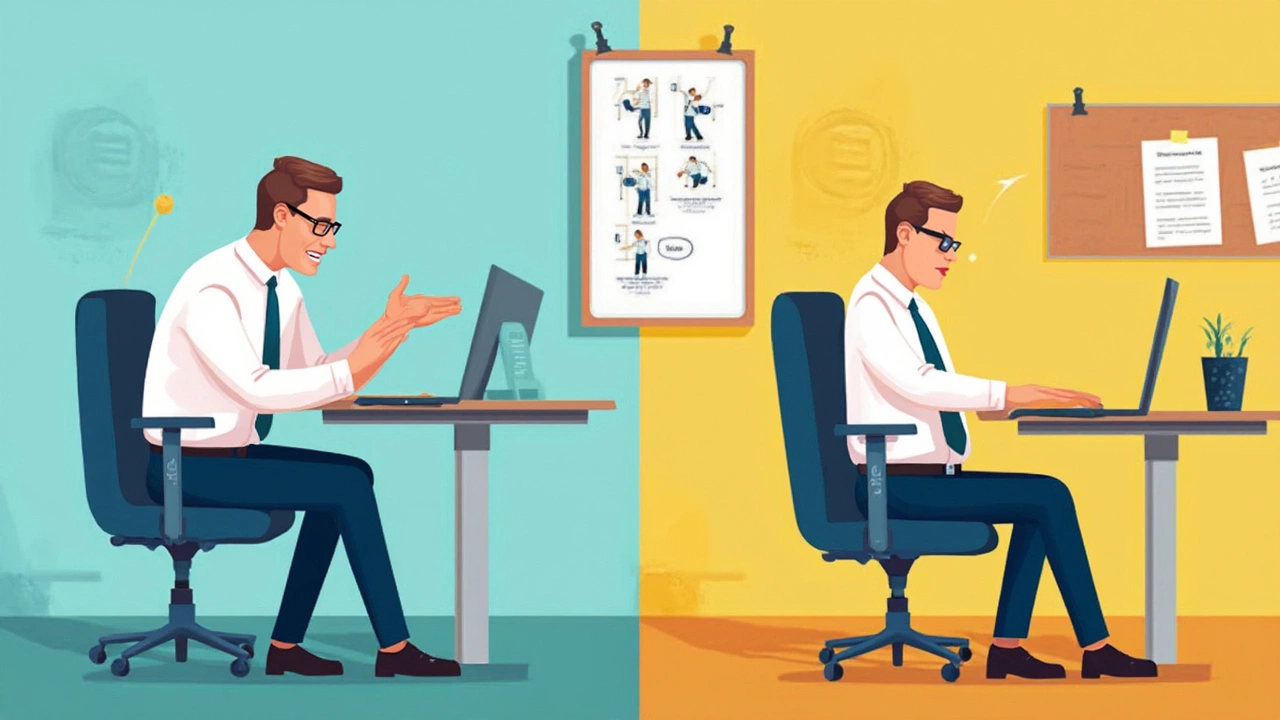 10
May,2025
10
May,2025
If you catch yourself slumping while reading this, you’re not alone. Most people who work at a desk slouch, usually without thinking about it. It’s not just about laziness—spending hours in front of a screen makes it hard for our spines to stay upright.
The big question: Can you actually fix slouching, or is it just how office life is now? Good news—posture isn’t set in stone. You can train your body to sit better, even if you’ve been hunched for years. It takes some effort and a few simple changes, but yes, you can absolutely see results.
Let’s get one thing straight: it’s not only about sitting up straight for five minutes here and there. Your muscles and joints adapt to what you do most. If you slouch all day, your body starts treating that as the “normal” position. But, when you use the right tools—decent chairs, proper desk setup, tiny, consistent adjustments—your body can relearn what healthy posture feels like.
Think about this: researchers found that people who made tiny posture changes throughout the day saw less back pain in just a couple of weeks. No hardcore workouts, no expensive gadgets—just little tweaks and better habits. The trick? Knowing which changes actually help and which are just hype.
- Why We Slouch (and How It Happens)
- What Slouching Really Does to Your Body
- Are Office Chairs to Blame?
- How to Train Your Posture Back
- Quick Fixes That Actually Work
- Habits to Keep Your Posture on Track
Why We Slouch (and How It Happens)
Slouching usually sneaks up on you. You start out sitting upright, but twenty minutes later, your back curves and your shoulders drop. What’s going on here? It’s a mix of habit, muscle fatigue, and—let’s be honest—bad chair design.
The main culprit? Long stretches of sitting in one position. Your body gets tired, especially the muscles that hold you upright. When these muscles get lazy, your body naturally takes the path of least resistance and slumps forward. Over time, your muscles and joints get used to this new position, making it even harder to snap back to better posture.
Why do we find it so tough to stay straight? Our brains are wired to look for comfort and efficiency. Sitting up tall takes more work than letting your muscles relax and letting gravity do its thing. Toss in a poorly set-up desk or an unsupportive chair and you’ve got a recipe for slouching.
Don’t forget distractions. When you get sucked into emails, spreadsheets, or social media, you stop noticing how you’re sitting. Researchers at a British university tracked desk workers for a week. They learned most folks slouched without realizing it, especially after lunch or late in the workday.
It’s not always your fault, though. Many office chairs are made with one-size-fits-all designs that simply don’t fit most people well. If your feet don’t touch the ground or your back doesn’t touch the chair, your body starts hunting for a comfortable position—usually ending up in a lazy slump.
So, if you spot yourself hunching, you’re not just being lazy. Your habits, energy levels, and environment all conspire to pull your slouching posture into daily life. Fixing it means working against all these little forces—one step at a time.
What Slouching Really Does to Your Body
Ever wonder what’s actually going on in your body when you slouch? It’s not just about looking a little hunched. When you’re in that rounded position for hours, your spine, muscles, and even your mood take a hit.
First off, slouching puts extra pressure on your spinal discs. That’s those rubbery cushions between your vertebrae. When you lean forward, those discs get squeezed more in the front, which can eventually lead to herniated discs or long-term back pain. Not fun.
Your neck isn’t off the hook either. Think about it—your head is pretty heavy, usually around 10-12 pounds. When your head juts forward, it’s like making your neck muscles hold up a bowling ball all day. That’s why a lot of people who slouch end up with tense shoulders and annoying neck aches.
Check out this quick table showing how slouching stacks up against normal sitting in terms of pressure on your lower back:
| Posture | Pressure on Lumbar Discs (units) |
|---|---|
| Standing upright | 100 |
| Sitting, good posture | 140 |
| Sitting, slouched | 185 |
Slouching also messes with your breathing. When you bend forward, your lungs don’t have as much room to expand. You might actually take shallower breaths without realizing it, which can make you feel more tired or even stressed out.
It’s not just physical stuff, either—some studies show that hunching over all day can actually lower your self-confidence and make you feel more stressed. So yeah, it’s got some real side effects beyond just looking sluggish.
Bottom line: slouching posture does a lot more than just make you uncomfortable for a few hours. Whether it’s headaches, long-term stiffness, or a bad mood, the effects can really stick with you unless you do something about it.
Are Office Chairs to Blame?
Office chairs sure get pointed at a lot when people talk about slouching posture. Are they really the bad guys, or just an easy scapegoat? Turns out, it’s a bit of both. Most workplace chairs aren’t designed for long, healthy sitting. They’re mass-produced, and in plenty of cases, ergonomic features like lumbar support or adjustable height are missing—or worse, totally ignored by the user.
A chair that’s not set up for your body shape or sitting style pushes you to slouch. No lower back support? Your spine collapses. Seat too high or low? Your shoulders hunch. Over time, these little mismatches add up.
Check out the numbers: a recent workplace study tracked over 400 office workers for six months. Here’s what they found:
| Factor | Linked to Slouching (%) |
|---|---|
| No lumbar support | 73% |
| Chair too high/low | 61% |
| No adjustable armrests | 49% |
| Use of ergonomic chair (properly set up) | 18% |
Surprised by that last line? Even when people had the fancy ergonomic chair, only a handful actually adjusted them right. That’s like buying a pro bike but never fixing the seat; you’re not getting any real benefit.
But hey, don’t rush out and drop a fortune on a new chair yet. The best seat in the world won’t help if you don’t use it properly. A decent office chair can definitely make it easier to sit well, but good posture depends on your setup and habits, too. Here’s how to squeeze the most from the chair you already have:
- Your feet flat on the floor, knees level with hips
- Lower back pressed lightly into the backrest
- Armrests at elbow height so your shoulders relax
- Monitor at eye level so you aren’t craning forward
If your chair is stubborn and can’t be adjusted, mix in a rolled-up towel at your lower back or stack some books under your monitor. It’s about making the best of what you’ve got, not waiting for the perfect chair.

How to Train Your Posture Back
Fixing bad posture isn’t a one-time deal—think of it like building a habit. You’re basically retraining muscles that got used to slouching. This takes some real action, but it’s easier than it sounds if you start small and stay consistent.
First, set up your workspace. Make sure your screen is at eye level, feet flat on the ground, and your chair supports your lower back. If your chair is missing lumbar support, try rolling up a towel and wedging it behind your back. This quick fix actually works for a lot of people, not just those with expensive gear.
Regular movement is huge. One study from 2023 showed that people who stood up or stretched every 30 minutes had about 32% less back pain than those who sat still. Even tiny shifts in your seat help reset your muscles. Use a timer or put a sticky note on your monitor as a reminder.
- Every half hour, stand and stretch for just a minute.
- Squeeze your shoulder blades together for 10 seconds several times a day.
- Sit with your hips back in the chair and shoulders relaxed, not rounded forward.
- When walking, look ahead rather than down at your phone.
- Test an app or wearable that buzzes when you slouch. These aren’t magic, but they do keep you aware.
Strong core muscles make a big difference, too. Core doesn’t just mean abs—your back and sides count. Simple exercises like planks or wall sits, done for a few minutes daily, train your body to support itself even outside the gym.
Check out this basic table for tips and how often to do them:
| Action | How Often |
|---|---|
| Stand & stretch | Every 30 minutes |
| Shoulder blade squeeze | 3-4 times a day |
| Check chair setup | Once a day |
| Core exercises | 3-4 times a week |
| Posture reminder apps | Optional—try for 2 weeks |
Teaching your body to sit well is a process. But with little daily effort, your slouching posture can turn into a thing of the past. Stay patient, make daily tweaks, and your back will thank you.
Quick Fixes That Actually Work
Here’s the honest truth: you don’t need a fancy contraption to start fixing your posture. There are some easy hacks you can add to your routine—right now, without dropping a dime. These quick fixes get you closer to upright, even if you’re glued to your office chair all day.
First up: set a timer every 30 to 45 minutes as a reminder to check your posture. Just stand up, stretch, or walk around for a minute. Research from the CDC shows that regular movement breaks can cut the risk of lower back pain by up to 32% for office workers.
Roll up a towel or grab a small cushion and stick it behind your lower back. This lumbar support nudges your spine into a healthier curve, fighting off that deep slouch. A simple hack, but it does wonders.
Don’t have time for a long stretch? Try these sneaky ways to reset:
- Posture pulse: Press your shoulder blades back and down for 10 seconds. Do this a few times a day, especially if you feel your back rounding.
- Keep your screen at eye level. If you’re looking down all the time, your neck and shoulders will slump. Stack books under your monitor if you don’t have a riser.
- Plant your feet flat on the ground, not tucked under you. That stable base keeps your whole body lifted.
- Use the "90-90-90" rule: hips, knees, and ankles at 90-degree angles while you sit in your chair.
Want some numbers on what works? Check this out:
| Quick Fix | Improvement Rate (per research) |
|---|---|
| Frequent movement breaks | 32% less lower back pain |
| Lumbar support (towel/cushion) | 24% better sitting posture scores |
| Monitor at eye level | 19% less neck strain |
One more thing: make a tiny sign and stick it on your screen that just says “slouching posture? Check!” That split-second reminder helps you catch yourself before you melt into your chair again.
Habits to Keep Your Posture on Track
Changing your posture isn’t a one-and-done fix. You need daily habits that stick even when you’re busy or zoned out at work. Here’s what actually works, based on research and practical experience.
First, don’t try to force yourself to sit bolt upright for hours. You’ll just get tired and probably end up more slouched than before. The secret is building tiny routines that remind you to reset your position throughout the day. Here are some habits worth adding:
- Set a timer: Every 30-45 minutes, stand up or do a quick stretch. Simple phone alarms or free computer apps can nudge you before you start to sink back into your chair.
- Plant your feet: Keep both feet flat on the floor. Crossing your legs or perching on one foot pulls your spine out of alignment. Adjust your chair so your knees are about level with your hips.
- Check your screen: Make sure your monitor is right at eye level, about an arm’s length away. You shouldn’t have to tilt your head up or down to see it.
- Move more: Even tiny movements help. Shift your weight, roll your shoulders, or wiggle your toes while working. The less stiff you get, the better your slouching posture will improve.
- Sit back in your chair: Use the chair’s backrest, not just the edge of the seat. Good lumbar support helps keep your spine naturally curved.
- Use reminders: Stick a Post-it near your screen or a fun wallpaper with a "straighten up" message. Little cues make a big difference long term.
There’s some cool data to back up these tips. A 2022 study from the Occupational Health Journal showed that office workers who broke up their sitting every 30 minutes with one minute of movement cut their back pain levels by nearly 50% over two months. The table below shows how simple posture habits affect back pain improvement:
| Habit | Reported Back Pain Reduction (%) |
|---|---|
| Movement Breaks (every 30 min) | 48 |
| Screen at Eye Level | 30 |
| Lumbar Support Use | 25 |
| Stretching Daily | 22 |
Stick with these habits and you’ll start noticing your posture gets better without thinking much about it. Make them part of your routine and you won’t be stuck fighting slouching posture all day long.




